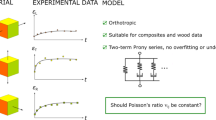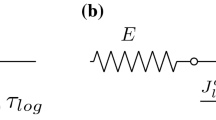Abstract
The present work is the subject of an identification of the viscoelastic behavior of olive wood in creep. Creep bending tests are applied to a cantilever beam fixed at the left end and subjected to a concentrated load at its free end. The applied loads are sufficiently small that they cannot produce viscoplastic strain. A four-parameter viscoelastic model was adopted to reproduce the viscoelastic creep of wood. The elastic modulus is determined directly from the deflection creep curves. It increases with increasing load. The viscoelastic parameters of the studied model are identified using an inverse analysis technique. These parameters increase with increasing load. The test model creep curves show satisfactory consistency.








Similar content being viewed by others
References
Bartolucci B, De Rosa A, Bertolin C, Berto F, Penta F, Siani AM (2020) Mechanical properties of the most common European woods: a literature review. Frattura Ed Integrità Strutturale 14(54):249–274
Besson J, Cailletaud G, Chaboche J-L, Forest S, Blétry M (2010) Non-linear mechanics of materials. In: Gladwell GML (ed) Vol. 167. Springer, Cham.
Bouhamed N, Souissi S, Marechal P, Amar MB, Lenoir O, Leger R, Bergeret A (2020) Ultrasound evaluation of the mechanical properties as an investigation tool for the wood-polymer composites including olive wood flour. Mech Mater 148:103445
Dahmen S, Ketata H, Ghozlen MHB, Hosten B (2010) Elastic constants measurement of anisotropic Olivier wood plates using air-coupled transducers generated Lamb wave and ultrasonic bulk wave. Ultrasonics 50(4–5):502–507
Formato A, Ianniello D, Pellegrino A, Villecco F (2019) Vibration-based experimental identification of the elastic moduli using plate specimens of the olive tree. Machines 7(2):46
Golberg DE (1989) Genetic algorithms in search, optimization, and machine learning. Addion wesley, New York.
Hamdi S, Eddine R, Moutou P, Gril J (2018) Moisture driven damage growth in wood material: 3D image analysis for viscoelastic numerical model validation. In: 2018 World conference on timber engineering. Seoul, South Korea.
Hassani MM, Wittel FK, Hering S, Herrmann HJ (2015) Rheological model for wood. Comput Methods Appl Mech Eng 283:1032–1060
He M-J, Zhang J, Li Z, Li M-L (2016) Production and mechanical performance of scrimber composite manufactured from poplar wood for structural applications. J Wood Sci 62:429–440
Holland JH (1975) Adaptation in natural and artificial systems: an introductory analysis with applications to biology, control, and artificial intelligence. U Michigan Press, Michigan.
Huang WZSSX, Chen ZHRXG (2011) Research on static and dynamic mechanical properties of spruce wood by three loading directions. Chin J Theor Appl Mech 43(6):1141–1150
Lemaitre J, Chaboche JL (1994) Mechanics of solid materials. Cambridge University Press, Cambridge.
Marques SP, Creus GJ (2012) Computational viscoelasticity. Springer, Cham.
McCall J (2005) Genetic algorithms for modelling and optimisation. J Comput Appl Math 184(1):205–222
Moutee M, Fortin Y, Fafard M (2007) A global rheological model of wood cantilever as applied to wood drying. Wood Sci Technol 41(3):209–234
Moutee M, Fortin Y, Laghdir A, Fafard M (2010) Cantilever experimental setup for rheological parameter identification in relation to wood drying. Wood Sci Technol 44(1):31–49
Mukudai J, Yata S (1987) Further modeling and simulation of viscoelastic behavior (bending deflection) of wood under moisture change. Wood Sci Technol 21(1):49–63
Neumann M, Jürgen H, Droste BO, Sylvius H (2011) Compressive behaviour of axially loaded spruce wood under large deformations at different strain rates. Euro J Wood Wood Products 69(3):345–357
Ozyhar T, Hering S, Niemz P (2013) Viscoelastic characterization of wood: time dependence of the orthotropic compliance in tension and compression. J Rheol 57(2):699–717
Pang S, Liang Y, Tao W, Liu Y, Huan S, Qin H (2019) Effect of the strain rate and fiber direction on the dynamic mechanical properties of beech wood. Forests 10(10):881
Saadallah Y, Derfouf S, Guerira B (2019) A viscoelastic-viscoplastic model for a thermoplastic and sensitivity of its rheological parameters to the strain-rate. Frattura Ed Integrità Strutturale 13(49):666–675
Salençon J (2009) Viscoélasticité pour le calcul des structures. Palaiseau: Editions de l'école polytechnique.
Wang GY, Wang M (2011) Multi-parameter identification of geomembrane viscoelastic-plastic creep constitutive model by genetic algorithm. Paper read at Applied Mechanics and Materials.
Wouts J, Haugou G, Oudjene M, Coutellier D, Morvan H (2016) Strain rate effects on the compressive response of wood and energy absorption capabilities—Part A: experimental investigations. Compos Struct 149:315–328
Author information
Authors and Affiliations
Corresponding author
Additional information
Publisher's Note
Springer Nature remains neutral with regard to jurisdictional claims in published maps and institutional affiliations.
Rights and permissions
Springer Nature or its licensor (e.g. a society or other partner) holds exclusive rights to this article under a publishing agreement with the author(s) or other rightsholder(s); author self-archiving of the accepted manuscript version of this article is solely governed by the terms of such publishing agreement and applicable law.
About this article
Cite this article
Saadallah, Y., Flilissa, S. & Hamadouche, B. Viscoelastic creep in bending of olive wood (Olea Europea L.). J Indian Acad Wood Sci (2024). https://doi.org/10.1007/s13196-024-00337-2
Received:
Accepted:
Published:
DOI: https://doi.org/10.1007/s13196-024-00337-2




